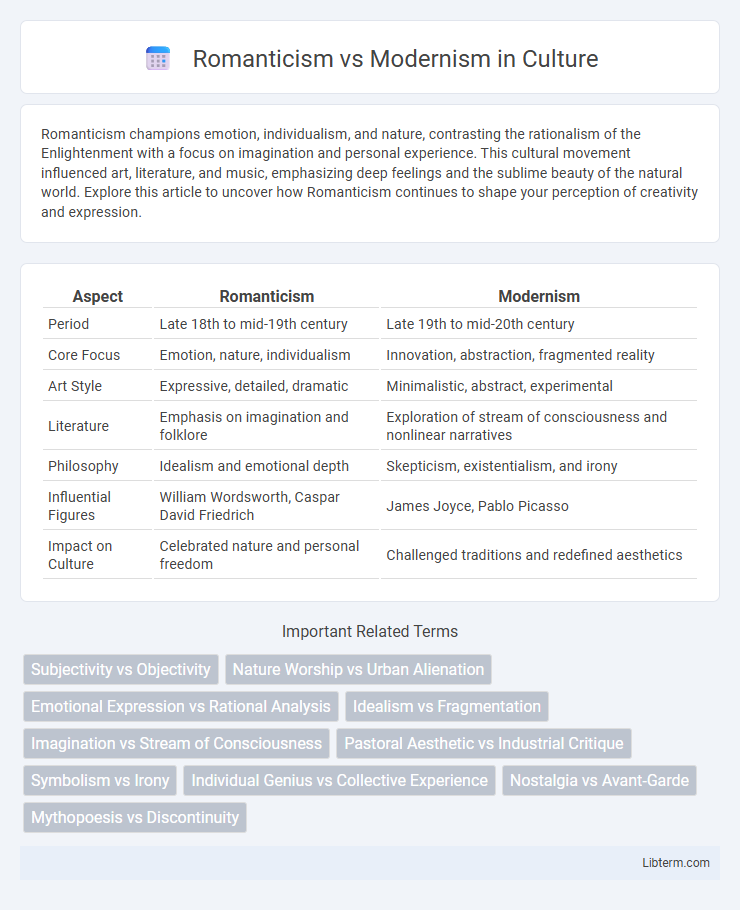Romanticism champions emotion, individualism, and nature, contrasting the rationalism of the Enlightenment with a focus on imagination and personal experience. This cultural movement influenced art, literature, and music, emphasizing deep feelings and the sublime beauty of the natural world. Explore this article to uncover how Romanticism continues to shape your perception of creativity and expression.
Table of Comparison
| Aspect | Romanticism | Modernism |
|---|---|---|
| Period | Late 18th to mid-19th century | Late 19th to mid-20th century |
| Core Focus | Emotion, nature, individualism | Innovation, abstraction, fragmented reality |
| Art Style | Expressive, detailed, dramatic | Minimalistic, abstract, experimental |
| Literature | Emphasis on imagination and folklore | Exploration of stream of consciousness and nonlinear narratives |
| Philosophy | Idealism and emotional depth | Skepticism, existentialism, and irony |
| Influential Figures | William Wordsworth, Caspar David Friedrich | James Joyce, Pablo Picasso |
| Impact on Culture | Celebrated nature and personal freedom | Challenged traditions and redefined aesthetics |
Introduction to Romanticism and Modernism
Romanticism, emerging in the late 18th century, emphasized emotion, individualism, and nature as a reaction against the rationalism of the Enlightenment. Modernism, developing in the late 19th and early 20th centuries, rejected traditional forms and conventions, seeking new expressions through experimentation and fragmented narratives. Both movements reflect profound shifts in cultural and artistic perspectives, highlighting contrasting approaches to creativity and human experience.
Historical Context: Origins and Development
Romanticism emerged in the late 18th century as a reaction against the Industrial Revolution and Enlightenment rationalism, emphasizing emotion, nature, and individualism. Modernism developed in the early 20th century, influenced by rapid technological advancements, World War I, and urbanization, challenging traditional forms and embracing experimentation. Both movements reflect cultural shifts, with Romanticism rooted in pre-industrial nostalgia and Modernism shaped by modernity's complexities.
Key Philosophical Foundations
Romanticism centers on emotion, individualism, and the sublime in nature, emphasizing intuition and the human spirit as responses to the rationalism of the Enlightenment. Modernism rejects traditional forms and embraces fragmentation, ambiguity, and a focus on subjective experience, reflecting skepticism about progress and objective truth. Both movements challenge prior conventions, yet Romanticism idealizes the past and natural harmony, while Modernism confronts the complexities and alienation of contemporary life.
Major Themes and Motifs Compared
Romanticism emphasizes nature, emotion, individualism, and the sublime, often celebrating imagination and the spiritual connection to the natural world. Modernism, by contrast, explores themes of fragmentation, alienation, and the breakdown of traditional structures, reflecting the complexities of industrialization and urban life. Motifs in Romanticism include pastoral landscapes and heroic solitude, while Modernism features disjointed narratives and experimental forms to convey uncertainty and disillusionment.
Notable Figures in Romanticism
Notable figures in Romanticism include William Wordsworth, Samuel Taylor Coleridge, and Lord Byron, who emphasized emotion, nature, and individualism in their works. Their poetry and prose contrasted sharply with the rationalism and industrial themes that characterized later Modernism, represented by figures like T.S. Eliot and James Joyce. Romanticism's celebration of imagination and emotional depth laid the groundwork for the diverse, experimental approaches found in Modernist literature.
Influential Modernist Authors and Artists
Influential Modernist authors such as James Joyce, Virginia Woolf, and T.S. Eliot revolutionized literature by experimenting with stream of consciousness, fragmented narratives, and symbolic imagery, contrasting the emotional expressiveness and idealism of Romanticism. In the visual arts, artists like Pablo Picasso, Marcel Duchamp, and Wassily Kandinsky challenged traditional aesthetics through Cubism, Dadaism, and Abstract Expressionism, emphasizing innovation and abstraction over Romantic naturalism and emotional depth. This shift reflected a broader cultural movement towards exploring the complexities of the modern psyche, urban experience, and technological change.
Differences in Artistic Techniques and Styles
Romanticism emphasizes emotional expression, dramatic contrasts, and nature-inspired motifs, often utilizing vivid colors and dynamic compositions to evoke individual experience and sublime beauty. Modernism breaks from traditional forms, favoring abstraction, minimalism, and experimentation with new materials and techniques to reflect industrialization and fragmented reality. The shift from Romanticism's detailed, representational art to Modernism's conceptual and non-representational approach marks a fundamental change in aesthetic priorities and artistic methods.
Socio-Political Influences on Each Movement
Romanticism emerged as a reaction against the Industrial Revolution and Enlightenment rationalism, emphasizing individualism, emotion, and nature as responses to social upheaval and the mechanization of life. Modernism developed amid the alienation and fragmentation of the early 20th century, influenced by World War I, urbanization, and rapid technological advancement that questioned traditional values and authority. Both movements reflect distinct socio-political challenges: Romanticism valorized personal freedom and natural beauty amidst growing industrial control, while Modernism sought to redefine identity and art in a fractured, modern society.
Lasting Impact on Literature and Art
Romanticism's lasting impact on literature and art is evident in its emphasis on emotion, individualism, and nature, inspiring works that explore human experience and imagination. Modernism revolutionized these fields by embracing abstraction, fragmentation, and new narrative techniques, reflecting the complexities of the 20th century. Both movements reshaped artistic expression, with Romanticism fostering depth of feeling and Modernism pushing boundaries of form and perception.
Conclusion: The Enduring Legacy of Romanticism and Modernism
Romanticism and Modernism each left an indelible mark on literature, art, and culture by challenging the norms of their times and fostering innovation in expression and thought. Romanticism's emphasis on emotion, nature, and individualism endures in contemporary creative practices, while Modernism's focus on experimentation, fragmentation, and new perspectives continues to influence modern artistic and literary movements. Their enduring legacies coexist as foundational pillars that shape how we understand human experience and creativity today.
Romanticism Infographic

 libterm.com
libterm.com